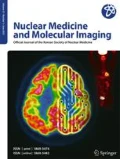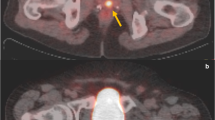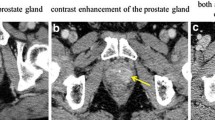Abstract
Purpose
This study aimed to evaluate the possibility that Bacillus Calmette-Guérin (BCG)-induced granulomatous prostatitis can be a potential cause of benign F-18 FDG uptake.
Methods
A total of 395 bladder cancer patients who underwent F-18 FDG PET/CT (PET/CT) were retrospectively evaluated. Patients were divided into two groups according to BCG therapy status. Elapsed time after BCG therapy, serum PSA level, results of prostate biopsy, and the SUVmax and uptake pattern in the prostate gland were reviewed. For patients who underwent follow-up PET/CT, the changes in SUVmax were calculated.
Results
While 35 % of patients showed prostate uptake in the BCG therapy group, only 1 % showed prostate uptake in the non-BCG therapy group (p < 0.001). Among 49 patients with FDG-avid prostate lesions, none had suspected malignancy during the follow-up period (median: 16 months). Five patients revealed granulomatous prostatitis on biopsy. The incidence of FDG-avid prostate lesions was significantly higher if the elapsed time after BCG therapy was less than 1 year compared to more than 1 year (p < 0.001). Serum PSA was normal in 88 % of patients. All patients with incidental F-18 FDG uptake in the prostate gland showed focal or multifocal prostate uptake, and median SUVmax was 4.7. In 16 patients who underwent follow-up PET/CT, SUVmax was decreased in 14 patients (88 %) without treatment, and no patients demonstrated further increased prostate uptake (p < 0.001).
Conclusions
BCG-induced granulomatous prostatitis can be a potential cause of benign F-18 FDG uptake, especially in those with a history of bladder cancer treated with BCG. In BCG-induced granulomatous prostatitis, focal or multifocal prostate uptake is frequently seen within 1 year after BCG therapy, and the intensity of prostate uptake is decreased on the follow-up PET/CT without any treatment.




Similar content being viewed by others
References
Han EJ, OJ H, Choi WH, Yoo IR, Chung SK. Significance of incidental focal uptake in prostate on 18-fluoro-2-deoxyglucose positron emission tomography CT images. Br J Radiol. 2010;83:915–20.
Hwang I, Chong A, Jung SI, Hwang EC, Kim SO, Kang TW, et al. Is further evaluation needed for incidental focal uptake in the prostate in 18-fluoro-2-deoxyglucose positron emission tomography-computed tomography images? Ann Nucl Med. 2013;27:140–5.
Kao PF, Chou YH, Lai CW. Diffuse FDG uptake in acute prostatitis. Clin Nucl Med. 2008;33:308–10.
Wilkinson C, Chowdhury F, Scarsbrook A, Smith J. BCG-induced granulomatous prostatitis—an incidental finding on FDG PET-CT. Clin Imaging. 2012;36:413–5.
Ilgan S, Koca G, Gundogdu S. Incidental detection of granulomatous prostatitis by F-18 FDG PET/CT in a patient with bladder cancer: a rare complication of BCG instillation therapy. Clin Nucl Med. 2009;34:613–4.
Kim CY, Lee SW, Yoon G, Jeong SY, Ahn BC, Lee J. Incidental detection of increased (18) F-FDG uptake and its follow-up in patients with granulomatous prostatitis after BCG treatment for urinary bladder cancer. Hell J Nucl Med. 2014;17:204–7.
Morales A, Eidinger D, Bruce AW. Intracavitary bacillus Calmette-Guerin in the treatment of superficial bladder tumors. J Urol. 1976;116:180–3.
LaFontaine PD, Middleman BR, Graham Jr SD, Sanders WH. Incidence of granulomatous prostatitis and acid-fast bacilli after intravesical BCG therapy. Urology. 1997;49:363–6.
Bevers RF, Kurth KH, Schamhart DH. Role of urothelial cells in BCG immunotherapy for superficial bladder cancer. Br J Cancer. 2004;91:607–12.
Balasar M, Dogan M, Kandemir A, Taskapu HH, Cicekci F, Toy H, et al. Investigation of granulomatous prostatitis incidence following intravesical BCG therapy. Int J Clin Exp Med. 2014;7:1554–7.
Lamm DL, van der Meijden PM, Morales A, Brosman SA, Catalona WJ, Herr HW, et al. Incidence and treatment of complications of bacillus Calmette-Guerin intravesical therapy in superficial bladder cancer. J Urol. 1992;147:596–600.
Leibovici D, Zisman A, Chen-Levyi Z, Cypele H, Siegel YI, Faitelovich S, et al. Elevated prostate specific antigen serum levels after intravesical instillation of bacillus Calmette-Guerin. J Urol. 2000;164:1546–9.
Beltrami P, Ruggera L, Cazzoletti L, Schiavone D, Zattoni F. Are prostate biopsies mandatory in patients with prostate-specific antigen increase during intravesical immuno- or chemotherapy for superficial bladder cancer? Prostate. 2008;68:1241–7.
Terris MK, Macy M, Freiha FS. Transrectal ultrasound appearance of prostatic granulomas secondary to bacillus Calmette-Guerin instillation. J Urol. 1997;158:126–7.
Logan JK, Walton-Diaz A, Rais-Bahrami S, Merino MJ, Turkbey B, Choyke PL, et al. Changes observed in multiparametric prostate magnetic resonance imaging characteristics correlate with histopathological development of chronic granulomatous prostatitis after intravesical Bacillus Calmette-Guerin therapy. J Comput Assist Tomogr. 2014;38:274–6.
Mukamel E, Konichezky M, Engelstein D, Cytron S, Abramovici A, Servadio C. Clinical and pathological findings in prostates following intravesical bacillus Calmette-Guerin instillations. J Urol. 1990;144:1399–400.
Conflict of interest
Choon-Young Kim, Sang-Woo Lee, Seock Hwan Choi, Seung Hyun Son, Ji-hoon Jung, Chang-Hee Lee, Shin Young Jeong, Byeong-Cheol Ahn, and Jaetae Lee declare that they have no conflicts of interest.
This manuscript has not been published before and is not under consideration for publication anywhere else. It has been approved by all co-authors.
Ethics Statement
This study was approved by the Institutional Review Board of Kyungpook National University Medical Center and School of Medicine, and the requirement for written informed consent was waived. This study has been performed in accordance with the ethical standards laid down in the 1964 Declaration of Helsinki and its later amendments.
Author information
Authors and Affiliations
Corresponding author
Rights and permissions
About this article
Cite this article
Kim, CY., Lee, SW., Choi, S.H. et al. Granulomatous Prostatitis After Intravesical Bacillus Calmette-Guérin Instillation Therapy: A Potential Cause of Incidental F-18 FDG Uptake in the Prostate Gland on F-18 FDG PET/CT in Patients with Bladder Cancer. Nucl Med Mol Imaging 50, 31–37 (2016). https://doi.org/10.1007/s13139-015-0364-y
Received:
Revised:
Accepted:
Published:
Issue Date:
DOI: https://doi.org/10.1007/s13139-015-0364-y




